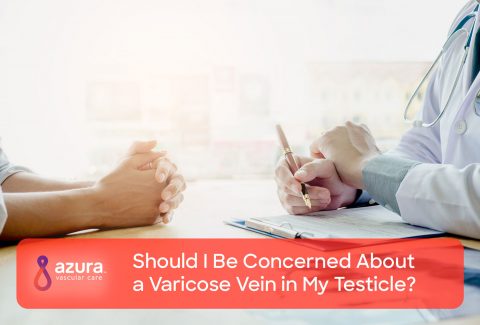
The doctor said you have a varicocele, but how serious is it? It’s an obvious question any man would ask when presented with a varicocele diagnosis. It’s estimated that around 15 percent of the male population have a varicocele, many without realizing it. It is a very common cause of infertility problems in men between the ages of 15 to 25, as well.i If you have a varicocele, then there are some things you should know about your diagnosis.
What Are Varicoceles?
Having a varicocele is similar to having varicose veins in your legs, but with some added complications. Unlike varicose veins, varicoceles are common in young men.i About 10 to 15 percent of boys have one, in fact.ii Eighty-five percent of males experience varicoceles on the left side, but they can appear bilaterally, as well.ii
Unlike varicose veins, varicoceles may come with some complications, including pain, testicular atrophy, and infertility.
What Causes Varicoceles?
Although it’s unclear why men develop a varicocele, this condition is likely related to valves in the veins. The valves in the veins help to return blood toward the heart for oxygenation. Contained within the spermatic cord are veins with valves that aid in keeping blood flowing properly.iii Without these valves, the blood would flow backward.
Weakness in the valves cause them to malfunction allowing the backward flow of blood. When that happens, the blood will pool around the last working valve putting pressure on the testicle, increasing the temperature and causing enlargement of the affected vein.iii
What Are the Symptoms of Varicoceles?
The symptoms of a varicocele vary. Some men have no symptoms at all. Those that do have varicocele symptoms experience:
- Sharp or dull scrotal pain that gets worse with physical exertion or long periods of standing
- Pain that intensifies during the day
- Pain that lessens when lying on your back
- Varicocele related infertility
Varicoceles are sometimes referred to as a bag of worms because of their appearance and feel. The dilatation of the veins of the varicoceles changes the appearance of the scrotum, making it look like one side is full of worms. Rather than doing a varicocele self-diagnosis, you may want to get a medical opinion if you believe you have a varicocele.
How Serious Is a Varicocele Diagnosis?
For couples trying to conceive a baby, a varicocele diagnosis can be very serious. Having a varicocele may cause a reduction in the sperm count and quality. Varicoceles are responsible for about 40 percent of all male infertility.i Varicocele-related infertility may be influenced by:
Low sperm count – The pooling of blood from the varicocele raises the temperature in the scrotum, disrupting what is normally a cool environment. When the temperature goes up, sperm count drops. High temperatures also affect the mobility and quality of the sperm.
Low testosterone levels –The pressure caused by the varicoceles damages the sensitive Leydig cells that produce testosterone. With appropriate treatment, research indicates that serum testosterone levels increase significantly.iv
Damage to the DNA in the sperm – Sperm DNA integrity is critical for normal fertilization. Varicocele repair improves sperm DNA quality.v
Poor-quality sperm – Sperm require motility to reach the egg for fertilization. Untreated varicoceles may interfere with the mobility and overall health of the sperm, reducing the odds of fertilization.
What Do the Different Grades of Varicoceles Mean?
Some varicoceles are not detected upon a physical exam. This would have been determined by the doctor using the Valsalva maneuver, a diagnostic tool where you would attempt to forcibly exhale while keeping the mouth and nose closed. If the physical exam was inconclusive, you would have likely received an ultrasound to determine your diagnosis.
A varicocele diagnosis often comes with varicocele grades that provide additional information about the seriousness of the condition.
- Grade 1: The varicocele is palpable with a Valsalva maneuver but not visible.
- Grade 2: The varicocele is palpable without a Valsalva maneuver but not visible.
- Grade 3: The varicocele is visible through the scrotum.vi

The doctor might also classify a varicocele as primary or secondary based on its location. A primary varicocele affects both the spermatic and renal vein. A secondary varicocele only impacts the internal spermatic vein.
What to Do After a Varicocele Diagnosis
Once the diagnosis is made, your doctor will discuss the treatment options with you, including surgical procedures that require hospitalization, possibly general anesthesia, and a longer recovery period.
Advances in varicocele treatments have led to nonsurgical options like varicocele embolization. Primarily done on an outpatient basis, varicocele embolization closes off the blood flow to the affected veins so the varicocele shrinks and eventually disappears. The body will reroute the blood flow to accommodate the closed vein.
If you are considering nonsurgical treatment options for your varicocele diagnosis, call 866.705.VEIN (8346) today to schedule an appointment with a vascular specialist.
Sources:
[i] http://urology.ucla.edu/body.cfm?id=478&action=detail&ref=19
[ii] http://www.urologyhealth.org/urologic-conditions/varicoceles
[iii] https://www.mayoclinic.org/diseases-conditions/varicocele/symptoms-causes/syc-20378771
[iv] https://www.medscape.org/viewarticle/758088
[v] https://www.ncbi.nlm.nih.gov/pmc/articles/PMC2664231/
[vi] Dubin L, Amelar RD. VARICOCELE SIZE AND RESULTS OF VARICOCELECTOMY IN SELECTED. Fertil Steril. 1970;21(8):606-609



